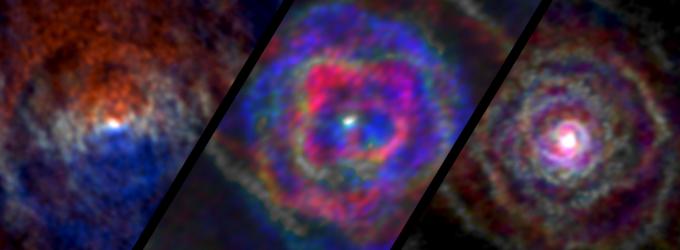In September 2020, researchers answered a longstanding question about why planetary nebulae display such a rich variety of shapes. Winds from aging stars produce planetary nebulae as the winds eject the stars' outer layers, shrouding the stars in stellar material. Views through early telescopes made this ejected material appear rounded and planet-like. As telescope technology improved, however, astronomers came to realize that planetary nebulae can look like flowers and butterflies, among other varied, asymmetrical shapes. Those shapes confounded astronomers, given their assumption that stellar winds are spherical in nature, similar to stars themselves, and should thus produce only rounded nebulae. The September 2020 study revealed, however, that these winds actually blow asymmetrically. Furthermore, as winds throw material off the star unevenly, stellar companions—such as other stars and planets—can scramble the material, rather like a spoon stirring creamer in hot coffee. Overall, these effects combine to produce the observed diversity of nebular forms. See also: Nebula; Planet; Planetary nebula; Star; Telescope; Wind

The insights into the true nature of stellar winds came from a large survey of 14 aging stars by the Atacama Large Millimeter/submillimeter Array, or ALMA. The observed stars are known as asymptotic giant branch stars, which are large, cool, red, and on the verge of producing planetary nebulae. With ALMA, astronomers observed the winds coming off these stars, discovering that the winds were varied in their shapes in the same way as planetary nebula. Further observations of stellar wind patterns indicated that companion stars and planets were also modifying the dispersal of windblown material. See also: Astronomical observatory; Giant star; Submillimeter astronomy
An improved understanding of asymptotic giant branch stars and the formation of planetary nebulae is important not only for refining stellar evolution models but also for planet formation and life (assuming that life exists beyond Earth). Aging stars are responsible for much of the enrichment of the vast spaces between stars with heavier elements that ultimately build up planets and would be needed by biology; astronomers estimate gas and dust contributions from asymptotic giant branch stars at 85% and 35%, respectively, of the total interstellar material. Closer to home, the Sun itself will become an asymptotic giant branch star in several billion years, and its eventual planetary nebula will extend far past the orbit of Earth. By observing these aging stars and the nebula they generate, astronomers are, in effect, looking into the distant future of our Sun and solar system. See also: Astrobiology; Interstellar matter; Solar system; Stellar evolution; Sun





